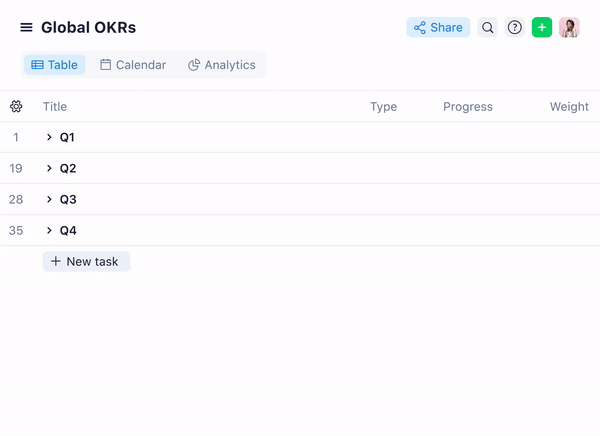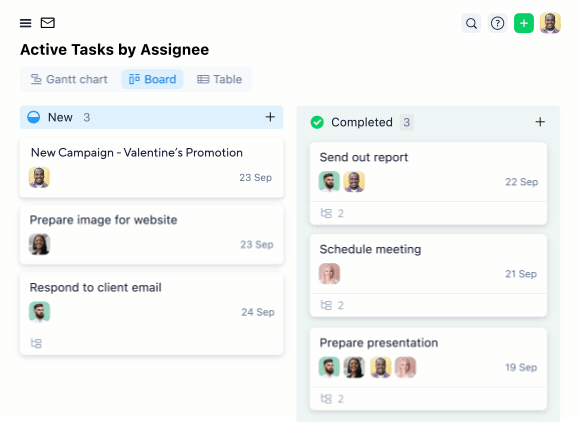Your large organization will have many different projects on the go at any given time. To handle the vast scale and variety of projects at an enterprise level, standard project management methodologies and tools just won’t cut it. Instead, enterprises are much better served by project portfolio management.
Rather than focusing on a single project at a time, portfolio management enables you to plan, oversee, and manage large groups of projects centrally. This way, you can better understand your projects in the context of everything you’re doing as an enterprise — and align them with your overall business strategy.
But how do you get started with enterprise project portfolio management (EPPM)?
In this guide, we break down the three key factors you’ll need in place before going anywhere, as well as five steps to take to make EPPM a success.
Note: From the get-go, it’s worth knowing that you won’t get far when managing enterprise project portfolios without the right tools. That’s why we’ll introduce you to Wrike, one of the top-rated project portfolio management tools on the market, according to Gartner.
The 3 fundamentals of enterprise project portfolio management
Enterprise project portfolio management is designed to give you a strategic perspective on the projects you’re managing. It joins up the dots between individual projects and aligns them with your goals and objectives as an enterprise.
So, EPPM is not just about getting projects completed on time. It’s also about ensuring that the projects you’re working on are the right ones for your enterprise in general — and that they’re feasible alongside all your other projects.
This means that, to even think about approaching project portfolio management, three things need to be in place first:
- An enterprise strategy: This includes your goals, objectives, and your roadmap to achieve your strategy. Smaller businesses may not need to select projects based on strategic considerations. But, as an enterprise, having a strategy that guides the selection, priority, and implementation of individual projects is critical.
- Dedicated governance: Individual project managers will continue to manage the individual projects. But, to coordinate the entire portfolio, an additional role might be needed within your organization. Typically, it’s the responsibility of the enterprise project management office (EPMO), acting as an intermediary between strategy and implementation. Their role is to oversee your enterprise’s project portfolios and ensure they’re running efficiently to help you achieve your goals.
- Powerful EPPM software: You won’t get very far with portfolio management if you’re relying on basic, limited project management software. EPPM tools (e.g., Wrike) act as the central command center for portfolios of projects by providing progress tracking, reporting, resource management, collaboration features, and more. They also let you automate key project management processes.
These are the basic building blocks of project portfolio management. But you now need to translate your strategy into a portfolio of projects.
You can do that through the following five steps.
5 steps to approach enterprise project portfolio management
Project portfolio management involves choosing the right projects for your strategic objectives and continually monitoring their performance, budget, and efficiency.
Here’s how to get started:
1. Extract your goals from the wider enterprise strategy
What’s your quarterly, annual, or longer-term focus? What are the associated objectives and how can you track success in the context of the wider goals? This is where enterprise PPM is different from basic project management, which is rarely interested in questions of business strategy. Project portfolio management pushes you toward bigger goals.
2. Capture and manage project requests and ideas
Now the projects come in. Enterprise organizations have ideas and requests coming in from everywhere — from internal teams, clients, and other places. Capturing these ideas demands a systematic approach. An enterprise project management office may use a spreadsheet or dedicated inbox to manage these ideas, while a specific department may have its own intake forms too.
3. Build a system to assess and prioritize projects
This step helps you put your strategy into practice, by establishing a standardized process that evaluates each project in a rigorous, objective way. When considering each project, ask yourself:
- Does this project really align with our goals?
- How much will it cost?
- How long will it take?
- Are the resources available?
- What’s the expected ROI?
- What are the potential risks?
This way, you’ll understand the feasibility of any given project, including the amount of resources it will require as well as the potential returns.
4. Validate your project portfolio
In the final stage of planning your portfolio, you need to determine whether your projects are feasible as a portfolio.
- Do you have capacity to be doing the planned projects at the same time?
- Are the same resources required by two separate projects?
- Will a delay in one project affect your ability to deliver another project?
- Can you afford to handle all these projects?
- Will these chosen projects be sufficient to meet your strategic goals?
Only once you’ve confirmed your portfolio’s feasibility can you sign up project managers for each project.
5. Manage and monitor your portfolio of projects
This is less of a finite task than an ongoing process. It involves:
- Monitoring project performance to ensure it’s running on time
- Tracking budget, resources, and capacity
- Measuring progress toward your goals, through key performance indicators (KPIs) and metrics
- Managing any conflicts between projects
- Aligning with stakeholders both within and outside of your enterprise
- Ensuring every project team has everything they need
- Identifying opportunities for efficiencies, savings, or automations
When you’re managing many different projects in your enterprise, it’s a lot to handle all by yourself. That’s why successful project portfolio managers tend to rely on specialist PPM software.
Real-world example: How Walmart Canada uses Wrike for project portfolio management
Walmart is the largest retailer in the world, with over 11,500 retail units in 27 countries. The enterprise uses Wrike in its Canadian operations to manage project portfolios in the Continuous Improvement team.
One of Walmart Canada’s priorities when using Wrike was to become more strategic about the projects it initiated, as Nicole Fakhri, Manager of Continuous Improvement, explains.
“We’re able to select the right projects, align them to our strategy, and ensure all the right resources are in place to execute them,” she says.
“Wrike allows management to answer some key questions. What are we already working on? Does it align with our corporate pillars? Does it align with what we’re trying to achieve within our strategy this year? Does this align with our corporate structure? Do we have the bandwidth and resources to attempt this? Does it actually get us where we need to go in five years?”
These are exactly the sorts of questions you should be asking during enterprise project portfolio management.
Read the whole case study here: Walmart Canada Automates Processes & Proves Project Value With Wrike.

Why Wrike is an essential tool for enterprise project portfolio management
The best software for portfolio management provides a single source of truth to identify, track, and report on efficiencies within your project portfolios.

Typically, standard project management tools won’t be up to the task of managing portfolios. That’s because they struggle to scale. They can get seriously cluttered when you have multiple projects on the go, plus they don’t tend to provide visibility on all your projects.
Our work management platform, Wrike, is different. We built it with enterprises in mind and it’s now used by the likes of Siemens Smart Infrastructure, Electrolux, The Estée Lauder Companies, and Capgemini.
Plus, it’s been top-rated by Gartner as one of the best project and portfolio management tools available, beating competition from the likes of Workfront, Smartsheet, and others.
Here are three reasons why Wrike is a valuable companion when you’re managing a portfolio of projects:
1. Wrike provides unmatched visibility over all your projects
One of the most important things you need when managing project portfolios is clear visibility over those projects.

While it sounds like it should be a pretty basic feature, many tools will be disappointing on this front. Besides getting cluttered at scale, most tools aren’t built to track dependencies between projects, while others aren’t customizable enough to fit your enterprise.
Instead, we built Wrike to make it easy to see how projects, tasks, and team members fit together, in an entirely customizable way.
- Customize your project structures to fit the way you work. Most project management systems force you into a different way of working. With Wrike, you can work in the way you want by creating custom item types, including tasks and projects.
- Get clarity on how different tasks and projects relate with cross-tagging. Cross-tagging is a feature entirely unique to Wrike. It enables you to track dependencies and tasks across multiple teams, without duplicating these items. This way, it provides the clarity you need at scale.
- Empower team members with customizable personal dashboards. With Wrike’s dashboards, every colleague has a unique view on your enterprise’s projects. They can see the tasks and dependencies that affect them across projects, whether through Kanban boards, Gantt charts, or other custom views.
We can confidently say that Wrike is the most customizable enterprise project management software on the market. This way, it fits the way you work, at the scale at which you’re working.
2. Wrike offers robust reporting into project goals, progress, and resources
As a project portfolio manager, you’ll always need an eye on costs. In your enterprise, different projects will often be competing for the same limited budget, so it’s crucial that you stay on track.
Wrike makes it easy to monitor and manage resources at scale and deliver on your goals, thanks to robust project planning and reporting tools.

- Track your enterprise goals. Set goals and monitor your progress toward them at every level of your organization. This makes it easy to align your portfolio with your key objectives.
- Plan, prioritize, and allocate resources effortlessly. Wrike lets you quickly estimate resource needs for specific projects. For instance, you can accurately determine project budgets with resource estimation tools. Plus, you can make sure that high-priority projects have the coverage they need with clear visibility over resource allocation.
- Track team performance and time spent on projects. Maximize team performance with insights into time spent per project and colleague-specific timesheets. You can also use workload charts to easily reassign tasks to individuals with more capacity if you need to. This way, you can stay on track and on budget and ensure profitability.
- Dig into deep analytics that scale across all projects. Many project management tools limit reporting to individual projects, and this just isn’t useful at portfolio level. With Wrike, you can track and benchmark performance with advanced analytics and business intelligence.
3. Wrike lets you leverage automation for efficiency across your enterprise
In our experience, enterprises are often looking to make efficiencies in the way they run, oversee, and implement projects. But without the right EPPM system, it can be difficult to identify where those efficiencies can be made.
Wrike’s automation features enable you to quickly take advantage of efficiencies within your portfolio management processes. They let you save time, resources, and energy on the repetitive tasks that are specific to your organization.

- Automate project intake with dynamic request forms. As soon as a project is requested, Wrike can automatically set up the desired workflow, from start to finish. Plus, you can customize your request form with specific queries, so that you have all the information you need from the get-go.
- Integrate workflows across different tools. With Wrike, you can automate workflows in real time across other tools that you use, including Slack, Outlook, QuickBooks, and more. It helps you save additional time and centralize all your processes within your single portfolio software.
- Identify opportunities for automation with AI. Wrike’s Work Intelligence® solution uses AI to track commonly repeated tasks across your enterprise’s projects. Then, it suggests new opportunities for automation that you may have otherwise missed.
Swedish appliances brand Electrolux, for example, uses Wrike to find efficiencies within its project life cycle. The results have been impressive. Thanks to Wrike, Electrolux has reduced the amount of time spent on each project by as much as 30%, while reducing the number of emails sent by 50%.
Choose Wrike to support your enterprise project portfolio management
In this guide, we’ve explored the steps you need to get started with project portfolio management, from strategy to implementation. But as you’ve seen, effective EPPM is impossible without a tool that can manage the complexity of your portfolios at scale.
Wrike will do exactly that. With its unmatched customization, in-depth reporting, and suite of automation features, Wrike enables enterprises to deliver projects more efficiently, while making it easier for portfolio managers too.
Try Wrike for free to see how it can work for you.



